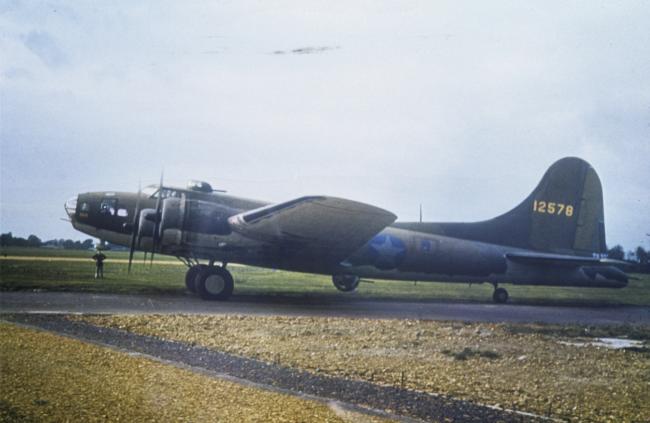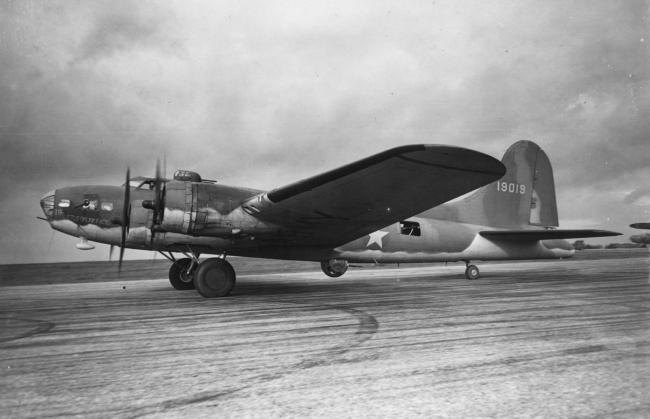Alconbury
Airfield
IWM, English Heritage Collection
Object Number - US_7GR_LOC334_V_5021 - Aerial photograph of Alconbury airfield, looking east. The technical site is at the top, the bomb dump is on the left, 9 May 1944. Photograph taken...
Alconbury had been constructed as a satellite airfield for RAF Upwood and Wyton and was used by RAF Squadrons: Nos. 15, 40 and 156. In preparation for the arrival of American heavy bombers, the base was developed in 1942 with the runways extended. When these extensions were finished the total area of land occupied by the base was 500 acres. Alconbury was the first Eighth Air Force base to be visited by King George VI, who visited the 93rd Bomb Group based there on 13 November 1942. In May 1943, while the 95th Bomb Group were stationed there, a fatal accident occurred. A 500lb bomb inexplicably went off whilst a B-17 was being loaded. It set off several others. Eighteen men were killed, twenty-seven injured and four B-17s completely destroyed. In the late summer of 1943 the 92nd Bomb Group left to make way for specialist Pathfinder Groups. It was announced in January 2015 by the US Department of Defense that RAF Alconbury will close as a USAFE base in 2022. The USAF intelligence and support elements currently located at RAF Alconbury and RAF Molesworth will be combined in a new complex at RAF Croughton, Northamptonshire. RAF Mildenhall, Suffolk, will also close as a USAFE base after 2020.
Connections
See how this entry relates to other items in the archive by exploring the connections below.
English Heritage's Record Description
A military airfield built in 1938 as a satellite airfield for Royal Air Force Wyton. The airfield initially had 3 runways. Until 1942, it was the base for 15, 40 and 156 Squadrons of the Royal Air Force. In 1942 the airfield was expanded to a 500 acre site, the length of the runways was increased and 26 hardstanding loops were added. In 1943 a Strategic Air Depot was built on the east side of the site in the village of Little Stukely. From 1942 onwards the site was used by the 8th United States Army Air Force. The 93rd bomber group flying Liberators were the first American Unit at the base, from September to December 1942; they were followed by the 92nd Bombardment Group, nicknamed "Fame's Famous Few", operating Flying Fortresses. For a short time between April and June of 1943 they were joined by 95th Bomber Group. On May 27th 1943, as aircraft were being armed there was an accidental detonation of some of the 500 pound bombs, which killed and injured a number of men and destroyed or damaged 15 aircraft. In September 1943 the 92nd moved out to be replaced by 482 Bombardment Group's pathfinders, operating B-17 Flying Fortresses and Liberators. From March 1944 they concentrated on testing and training with radar devices. The depot to the east side of the site was run as a seperate station by 2nd Strategic Air Depot. From November 1945 to 1948 the site was also used by the Royal Air Force 264 Munitions Unit. After World War Two the base continued to be used by the United States Air Force (Europe). The base was upgraded and modernised in 1951. In 1982 until the late 1980s the base was used by the 19th Reconnaissance Squadron. Special extra-wide hardened aircraft shelters were constructed to accommodate their large TR1 aircraft; in the late 1980s a 2-storey bunker was built as a centre for evaluating intelligence. The base closed in 1995. Some buildings survived in 2003, the site is said to be designated as a brown field site for housing or a distribution centre.
People

- Military/Civilian/Mascot: Military
- Nationality: American
- Unit: 100th Bomb Group 482nd Bomb Group 813th Bomb Squadron
- Service Numbers: 19058963
- Highest Rank: Technical Sergeant
- Role/Job: Top Turret Gunner

- Military/Civilian/Mascot: Military
- Nationality: American
- Unit: 92nd Bomb Group 407th Bomb Squadron
- Service Numbers: 11998665 /O-674111
- Highest Rank: Second Lieutenant
- Role/Job: Navigator
- Military/Civilian/Mascot: Military
- Nationality: American
- Unit: 482nd Bomb Group 814th Bomb Squadron
- Highest Rank: Sergeant
- Role/Job: Engineer
- Military/Civilian/Mascot: Military
- Nationality: American
- Unit: 482nd Bomb Group 96th Bomb Group 338th Bomb Squadron 812th Bomb Squadron
- Highest Rank: Lieutenant
- Role/Job: Navigator

- Military/Civilian/Mascot: Military
- Nationality: American
- Unit: 92nd Bomb Group 326th Bomb Squadron 327th Bomb Squadron
- Service Numbers: 37264777
- Highest Rank: Staff Sergeant
- Role/Job: Tail Gunner/Waist Gunner
Aircraft
![B-17 Flying Fortresses, including (VK-H, serial number 41-24606) nicknamed "Werewolf", of the 303rd Bomb Group. On reverse: US Army Examiner [Stamp].](https://assets.americanairmuseum.com/s3fs-public/styles/max_650x650/public/freeman/media-407638.jpg?itok=iyZL_QIB)
- Aircraft Type: B-17 Flying Fortress
- Nicknames: Werewolf
- Unit: 303rd Bomb Group 401st Bomb Group 91st Bomb Group 358th Bomb Squadron

- Aircraft Type: B-17 Flying Fortress
- Nicknames: Butcher Shop/ Big Tin Bird
- Unit: 97th Bomb Group 326th Bomb Squadron 340th Bomb Squadron 77th Fighter Squadron

- Aircraft Type: B-17 Flying Fortress
- Unit: 97th Bomb Group 341st Bomb Squadron 94th Bomb Group 95th Bomb Group 482nd Bomb Group 327th Bomb Squadron 92nd Bomb Group
![A B-17 Flying Fortress (serial number 41-9017) of the 92nd Bomb Group in flight. Passed for publication 5 Sep 1942. Printed caption on reverse: 'Q.13312: A Flying Fortress photographed in flight at a U.S. Training Centre.' On reverse: Westminster Press Provincial Newspapers Ltd and US Army General Section Press & Censorship Bureau [Stamps].](https://assets.americanairmuseum.com/s3fs-public/styles/max_650x650/public/freeman/media-408318.jpg?itok=l8MLcV3q)
- Aircraft Type: B-17 Flying Fortress
- Nicknames: Heidi Ho
- Unit: 385th Bomb Group 482nd Bomb Group 92nd Bomb Group 94th Bomb Group 97th Bomb Group 327th Bomb Squadron 342nd Bomb Squadron

- Aircraft Type: B-17 Flying Fortress
- Nicknames: Lil Skunk Face
- Unit: 305th Bomb Group 381st Bomb Group 482nd Bomb Group 92nd Bomb Group 97th Bomb Group 327th Bomb Squadron 414th Bomb Squadron
Revisions
Connected aircraft records that have 'Alconbury' in their biography fields.
Dates of American use added. Source: From Far Afield They Came... by Margaret Winham
USAFE-AFAfrica Press Release, 08 January 2015. See http://www.mildenhall.af.mil/news/story.asp?id=123435803.
Barry Anderson, Army Air Forces Stations (Alabama, 1985) / Roger Freeman, Airfields of the Eighth Then And Now (London, 1978).
![Lietuenant W.E Keefer, Lieutenant Phil Ziegler, Lieutenant Howard Young and Lieutenant Joe Walker, of the 93rd Bomb Group stand with their B-24 Liberator (serial number 41-23742) nicknamed "Liberty Lad" at Alconbury. In a duplicate version of this image a censor has obscured the insignia on the airmen's jackets and the structure visible beneath the aircraft to the far left of the image. Image stamped on reverse: 'Ministry of Information 10 Oct 1942.'[stamp] and '226088'[Censor no]. Printed caption on reve](https://assets.americanairmuseum.com/s3fs-public/styles/max_650x650/public/freeman/media-379205.jpg?itok=aM9gHbnM)
![Ground personnel of the 93rd Bomb Group carry out repairs to the engine of a B-24 Liberator at Alconbury. Image stamped on reverse: 'Passed for publication 11 Oct 1942'.'226127'[Censor no].'AIR SER' Printed caption on reverse: 'American bomber get 48. Associated Press Photo Shows: A Ground crew checks the engines of one of the giant bombers before take-off. AKP/ROB 252343.' Handwritten caption on reverse: '1002/RF 93BG mechanics at work on B-24D.'](https://assets.americanairmuseum.com/s3fs-public/styles/max_650x650/public/freeman/media-379207.jpg?itok=6sCfK3kW)
![Sergeant J. Gardener and Staff Sergeant H Sena, both ground personnel of the 93rd Bomb Group, work on the engine of a B-24 Liberator at Alconbury. Image stamped on reverse: 'AIR SER (LIBERATOR).'231048 '[Censor no].'Passed for publication 6 Nov 42'[stamp]. 'Planet News'[stamp]. Printed caption on reverse: 'Photo shows: "Liberators" flying engineers overhauling one of the engines, at a U.S.Army Air Corps station some-where in England. They are Sgt. J.C. Gardener, from Keyport, New Jersey, working over the](https://assets.americanairmuseum.com/s3fs-public/styles/max_650x650/public/freeman/media-379209.jpg?itok=GBumxKyj)
![Ground crew of the 93rd Bomb Group prepare to load bombs into a B-24 Liberator (serial number 41-23737) nicknamed "Eager Beaver" at Alconbury. Image stamped on reverse: 'Passed for publication 30 Oct 1942' [stamp].' 229840' [Censor no]. Printed caption on reverse: .'FIRST PICTURES OF THE "LIBERATOR" IN ACTION Oct 1942. First photograph of the giant "Liberator" American bomber to be taken at a US Army Air Corps Station in England. Already famous as being the craft in which Mr Churchill flew to Russia and t](https://assets.americanairmuseum.com/s3fs-public/styles/max_650x650/public/freeman/media-379211.jpg?itok=ZhCrG4K5)
![Ground personnel of the 93rd Bomb Group drag a bomb towards a B-24 Liberator (serial number 41-23745) nicknamed "Katy Bug" at Alconbury. Image stamped on reverse: 'Passed for publication 30 Oct 1942' [stamp].' 229829' [Censor no]. Printed caption on reverse: .'FIRST PICTURES OF THE "LIBERATOR" IN ACTION Oct 1942. First photograph of the giant "Liberator" American bomber to be taken at a US Army Air Corps Station in England. Already famous as being the craft in which Mr Churchill flew to Russia and the Nea](https://assets.americanairmuseum.com/s3fs-public/styles/max_650x650/public/freeman/media-379212.jpg?itok=JQEAb7M-)
![First Lieutenant Llewellyn L. Brown and First Lieutenant Robert J. Quinlivan admire the nose art of a B-24 Liberator (serial number 41-23724) nicknamed "Flying Cock" at Alconbury. Image stamped on reverse: '231046' [Censor no].' passed for publication 6 Nov 1942' [stamp]. Printed caption on reverse: 'PHOTO SHOWS: Pilot and co-Pilot of a "Liberator" on which is painted their mascot the "Flying Cock"', photographed at a U.S. Army Air Corps station somewhere in England. They are 1st Lieut. L.L. Brown (left),](https://assets.americanairmuseum.com/s3fs-public/styles/max_650x650/public/freeman/media-379213.jpg?itok=lP6auKuo)

![Ground Personnel, including Staff Sergeant Roland E. "Lefty" Nairn, of the 95th Bomb Group hoist a bomb beside a B-17 Flying Fortress at Horham. Nairn has written on reverse: 'Taken on base at Horham, Eng during Mar 45. Had I known about the excitement at Alconbury I would not have been so inquisitive. Before [?] I was Armourer-gunner. My curiosity got the best of me. R.E.Lefty Nairn 336sqdn 95th BG. Thats me second from left in Turned-up cap.'](https://assets.americanairmuseum.com/s3fs-public/styles/max_650x650/public/freeman/media-379266.jpg?itok=47UFmUrz)



